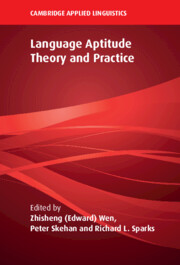Book contents
- Language Aptitude Theory and Practice
- The Cambridge Applied Linguistics Series
- Language Aptitude Theory and Practice
- Copyright page
- Contents
- Figures
- Tables
- Editors and Contributors
- Preface and Acknowledgments
- 1 Language Aptitude Research
- Part I Revisiting and Refining Aptitude Tests
- 2 The MLAT-Elementary
- 3 Testing Language Aptitude
- 4 The High-Level Language Aptitude Battery (Hi-LAB)
- 5 Exploring the Predictive Validity of the LLAMA (v1) Language Aptitude Tests
- Part II Aptitude Testing of Diverse Groups
- Part III Innovative Perspectives and Paradigms
- Part IV Aptitude–Treatment Interaction (ATI)
- Part V Final Commentaries
- Index
- References
2 - The MLAT-Elementary
History, Adaptations, and Current Uses
from Part I - Revisiting and Refining Aptitude Tests
Published online by Cambridge University Press: 27 May 2023
- Language Aptitude Theory and Practice
- The Cambridge Applied Linguistics Series
- Language Aptitude Theory and Practice
- Copyright page
- Contents
- Figures
- Tables
- Editors and Contributors
- Preface and Acknowledgments
- 1 Language Aptitude Research
- Part I Revisiting and Refining Aptitude Tests
- 2 The MLAT-Elementary
- 3 Testing Language Aptitude
- 4 The High-Level Language Aptitude Battery (Hi-LAB)
- 5 Exploring the Predictive Validity of the LLAMA (v1) Language Aptitude Tests
- Part II Aptitude Testing of Diverse Groups
- Part III Innovative Perspectives and Paradigms
- Part IV Aptitude–Treatment Interaction (ATI)
- Part V Final Commentaries
- Index
- References
Summary
The chapter first revisits the major developments of MLAT and its variants based on Stansfield & Reed (2019), and then turns to focus on the MLAT-Elementary test battery that was designed particularly for long-neglected groups of young L2 learners, including the history of MLAT-E, its applications and validations over the past five decades, and finally, and outline of its future.
Keywords
- Type
- Chapter
- Information
- Language Aptitude Theory and Practice , pp. 25 - 46Publisher: Cambridge University PressPrint publication year: 2023
References
- 1
- Cited by

